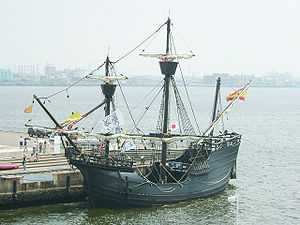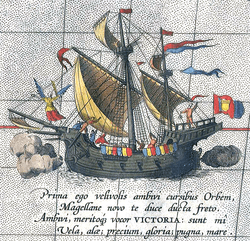Victoria (ship)
 | |
| Career (Crown of Spain) | |
|---|---|
| Name: | Victoria |
| Namesake: | Santa Maria de la Victoria |
| Owner: | Ferdinand Magellan/Sebastian Elcano |
| Ordered: | 1518 |
| Launched: | 1519 |
| Fate: | Disappeared en route to Seville from the Antilles, 1570 [1] |
| Notes: | First ship to circumnavigate the globe. |
| General characteristics | |
| Class and type: | Carrack |
| Tons burthen: | 85 |
| Length: | 18 to 21 metres (59 to 69 ft) |
| Complement: | 55 |
Victoria (or Nao Victoria, as well as Vittoria) was a Spanish carrack and the first ship to successfully circumnavigate the world. The Victoria was part of a Spanish expedition commanded by the Portuguese explorer Ferdinand Magellan, and after his death during the voyage, by Juan Sebastián Elcano. The expedition began with five ships but the Victoria was the only ship to complete the voyage. Magellan was killed in the Philippines. The ship was built at a shipyard in Gipuzkoa, with the Basques being reputed shipbuilders at the time, and along with the four other ships, it was given to Magellan by King Charles I of Spain. Victoria was named after the church of Santa Maria de la Victoria de Triana, where Magellan took an oath of allegiance to Charles V in order to be granted full access to the Spice Islands. Victoria was an 85 ton ship with a crew of 42.
The four other ships were Trinidad (110 tons, crew 55), San Antonio (120 tons, crew 60), Concepcion (90 tons, crew 45), and Santiago (75 tons, crew 32). Trinidad, Magellan's flagship, Concepcion, and Santiago were wrecked or scuttled; San Antonio deserted the expedition during the navigation of the Straits of Magellan and returned to Europe on her own.
Victoria was rated a carrack or nao (ship), as were all the others except Trinidad, which was a caravel.
Crew
The voyage started with a crew of about 265 men aboard five ships. Of all these, only 18 men returned alive on the Victoria. Many of the men died of malnutrition. Beginning the voyage, Luis De Mendoza was her captain. On April 2, 1520, after establishing a settlement they called Puerto San Julian, in Patagonia a fierce mutiny involving three captains broke out, but it was ultimately quelled.[2] Antonio Pigafetta's and other reports state that Luis de Mendoza and Gaspar Quesada, captain of the Concepcion were executed and the remains hung on gallows on the shore. [3][4] Juan de Cartagena, captain of San Antonio was marooned on the coast. Duarte Barbosa, a Portuguese who had sided with Magellan in facing the mutiny, then became the captain of "Victoria." According to Pigafetta, after Magellan's death on April 27, 1521, at the Battle of Mactan, remnants of the fleet tried to retrieve Magellan's body without success. Thereafter, Duarte Barbosa and João Serrão were elected leaders of the expedition. On May 1, 1521 they were invited by rajah Humabon of Cebu, of the Philippines to a banquet ashore to receive a gift for the king of Spain. There most were killed or poisoned, including Duarte Barbosa and João Serrão, who was brought by natives who wanted to exchange him for weapons, but was left behind. Pilot João Carvalho, who had survived the trap, then became the captain of "Victoria." In August, near Borneo he was deposed and Juan Sebastián Elcano became captain for the remainder of the expedition.
Returning Crew

Out of an entire expedition of 260 people, only 18 returned to Seville with the expedition (many others deserted), which by the end was only made up of the crew of the Victoria.
They were:
- Juan Sebastián Elcano, captain-general.
- Miguel de Rodas, boatswain (contramaestre) of Victoria.
- Francisco Albo, of Axio, island of Rodos, boatswain of Trinidad.
- Juan de Acurio, of Bermeo, boatswain of the Concepcion.
- Martino de Judicibus, of Genoa Italy, superintendent of Concepcion.
- Hernando de Bustamante, of Alcantara, barber of Concepcion.
- Juan de Zuvileta, of Baracaldo, page of Victoria.
- Miguel Sanchez, of Rodas, skilled seaman (marinero) of Victoria.
- Nicholas the Greek, of Nafplion, marinero of Victoria.
- Diego Gallego, of Bayonne, marinero of the Victoria.
- Juan Rodriguez, of Seville, marinero of the Trinidad.
- Antonio Rodriguez, of Huelva, marinero of Trinidad.
- Francisco Rodrigues, of Seville (a Portuguese), marinero of Concepcion.
- Juan de Arratia, of Bilbao, common sailor (grumete) of Victoria.
- Vasco Gomes Gallego (a Portuguese), grumete of Trinidad.
- Juan de Santandres, of Cueto, grumete of Trinidad.
- Martin de Isaurraga, of Bermeo, grumete of Concepcion.
- The Chevalier Antonio Pigafetta, of Vicenza, passenger.
- Hans Barge, of Aachen Germany, gunner.
Out of all these survivors, Antonio Pigafetta was the most significant because his journals supply most of the information known about the first expedition around the world.
Voyage
The long circumnavigation began in Spain in 1519 and returned early September 1522 after traveling 68,000 kilometres (42,000 mi), 35,000 kilometres (22,000 mi) of which was largely unknown to the crew. On December 21, 1521, Victoria sailed on alone because the other ships left the convoy due to lack of food/water rations. The ship was in terrible shape, with her sails torn and only kept afloat by continuous pumping of water. Victoria managed to pull through and return to Spain with a shipload of costly spices.
Victoria was later repaired, bought by a merchant shipper and sailed for almost another fifty years before being lost with all hands on a trip from the Antilles to Seville in about 1570.[1]
Replicas
In 2006, to celebrate the Bicentennial of Chile, an entrepreneur from Punta Arenas founded a project to build a replica of the first ship to circumnavigate the globe and discover the Strait of Magellan,[5] which was also one of the first European voyages to explore Chile’s extreme south. The search for the original plans of the Nao Victoria took longer than expected and the project was delayed by almost three years, from 2006 to 2009. The replica was finally completed by 2011. Although it was not possible to complete the project in time for the celebration of the bicentennial in 2010, the project’s creator has received a Presidential Medal from the President of Chile.[6]
References
- ↑ 1.0 1.1 Bergreen, Laurence (2003). "XV- After Magellan". Over the Edge of the World (1 ed.). New York City: HarperCollins. p. 413. ISBN 0-06-621173-5.
Little Victoria, the first ship to complete a circumnavigation, had her own curious epilogue. No one thought to preserve the battered vessel as a testament of Magellan's great achievement. Instead, she was repaired, sold to a merchant for 106,274 maravedis, and returned to service, a workhorse of the Spanish conquest of the Americas. As late as 1570, she was still plying the Atlantic. En route to Seville from the Antilles, she disappeared without a trace; all hands on board were lost. It is assumed that she encountered a mid-Atlantic storm that sent her to the bottom, her wordless epitaph written on the restless waves.
- ↑
- Murphy, Patrick J.; Coye, Ray W. (2013). Mutiny and Its Bounty: Leadership Lessons from the Age of Discovery. Yale University Press. ISBN 9780300170283.
- ↑
- Murphy, Patrick J.; Coye, Ray W. (2013). Mutiny and Its Bounty: Leadership Lessons from the Age of Discovery. Yale University Press. ISBN 9780300170283.
- ↑ "Ferdinand Magellan", Catholic Encyclopedia (New Advent), retrieved January 14, 2007
- ↑ Atlas Vivo de Chile – Nao Victoria www.atlasvivodechile.com Retrieved August 19, 2013
- ↑ "Presidente Sebastian Pinera expreso compromiso...". Radio Natales (in Spanish). 16 August 2010. Retrieved 2012-09-20.
External links
| Wikimedia Commons has media related to Victoria (ship, 1519). |
- "Ferdinand Magellan and the First Circumnavigation of the World". Age of Exploration. The Mariners' Museum. Retrieved 2008-04-28.